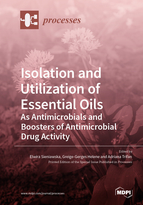Isolation and Utilization of Essential Oils: As Antimicrobials and Boosters of Antimicrobial Drug Activity
A special issue of Processes (ISSN 2227-9717). This special issue belongs to the section "Pharmaceutical Processes".
Deadline for manuscript submissions: closed (30 November 2021) | Viewed by 25670
Special Issue Editors
Interests: metabolomics; chromatography; essential oils; pharmacognosy; natural products; phytochemistry; antibacterial activity
Interests: pharmacognosy; natural products chemistry; essential oils; antimicrobials
Special Issues, Collections and Topics in MDPI journals
Special Issue Information
Dear Colleagues,
In the search for new antimicrobial lead structures, interest in natural product-based screening has enjoyed a renaissance, driven by the fact that plants present a unique pool of compounds. Volatiles produced by plants and present in essential oils possess a broad spectrum of biological properties with applications in many revenue-generating sectors, such as the pharmaceutical, nutraceutical, cosmetic, perfume, agronomy, and sanitary industries. Essential oils are a complex blend of small volatile molecules which play an important role in plant-defensive response to various insults, including microbial attacks, and their broad-spectrum antimicrobial activities have generated impressive scientific reports. Further, due to their multicomponent nature, essential oils have low potential for the development of microbial resistance. New antimicrobial combination drugs which include natural products have recently become a research priority. Synergistic interactions between essential oil constituents and antimicrobials are very promising approaches to overcome microbial resistance. The combinations of essential oil constituents and antimicrobial drugs can exert a multitarget activity, being effective in reducing or reversing microbial resistance. Additionally, such combinations have the advantage of reduced effective doses of both antimicrobial and essential oils, being consequently less toxic than their components. The encapsulation of essential oils in nano- and microdelivery systems (molecular inclusion complexes, polymeric and colloidal systems) is another promising antimicrobial strategy that is currently being extensively investigated. Formulation of essential oils is an efficient approach to boost their antimicrobial activity against different pathogens and also allows overcoming some limitations due to their physicochemical properties, such as low water solubility, high volatility, and chemical instability.
This Special Issue on “Isolation and Utilization of Essential Oils: As Antimicrobials and Boosters of Antimicrobial Drugs Activity” aims to curate novel advances in the development and application of essential oils as antimicrobial agents via combinatorial and nano-based approaches.
Topics include but are not limited to:
- The use of essential oils to prevent the emergence of antimicrobial resistance, to enhance the efficacy, and to minimize potential side effects of antimicrobial drugs;
- Combination therapy associating conventional antimicrobial drugs and essential oil constituents as a promising strategy in overcoming antimicrobial resistance;
- The mechanisms underlying antimicrobial enhancing or antimicrobial resistance reversal effects of essential oils constituents;
- Small-scale formulations as an efficient approach to improve solubility, stability, and to provide controlled-release delivery of essential oils and to boost their antimicrobial activity against different pathogens;
- Antimicrobial activity of drug delivery systems encapsulating essential oil compounds, with emphasis on their preparation methods and characteristics, benefits, mechanisms of action, and biocompatibility issues.
Dr. Elwira Sieniawska
Prof. Greige-Gerges Helene
Dr. Adriana Trifan
Guest Editors
Manuscript Submission Information
Manuscripts should be submitted online at www.mdpi.com by registering and logging in to this website. Once you are registered, click here to go to the submission form. Manuscripts can be submitted until the deadline. All submissions that pass pre-check are peer-reviewed. Accepted papers will be published continuously in the journal (as soon as accepted) and will be listed together on the special issue website. Research articles, review articles as well as short communications are invited. For planned papers, a title and short abstract (about 100 words) can be sent to the Editorial Office for announcement on this website.
Submitted manuscripts should not have been published previously, nor be under consideration for publication elsewhere (except conference proceedings papers). All manuscripts are thoroughly refereed through a single-blind peer-review process. A guide for authors and other relevant information for submission of manuscripts is available on the Instructions for Authors page. Processes is an international peer-reviewed open access monthly journal published by MDPI.
Please visit the Instructions for Authors page before submitting a manuscript. The Article Processing Charge (APC) for publication in this open access journal is 2400 CHF (Swiss Francs). Submitted papers should be well formatted and use good English. Authors may use MDPI's English editing service prior to publication or during author revisions.
Keywords
- antimicrobials
- essential oils
- synergy
- delivery systems
- microbial resistance
- small-scale formulations








